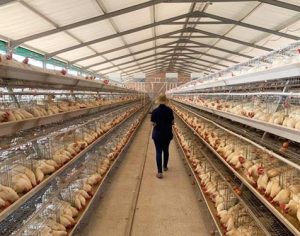Raising poultry, specifically layers for egg production, is a lucrative venture. However, the success of such an endeavor largely depends on the infrastructure and equipment used. One of the most efficient systems for rearing a large number of layers is the battery cage system. This article explores the costs, benefits, and considerations of using battery cage system for rearing 20,000 layers, with a focus on providing positive energy and actionable insights.

Understanding the Battery Cage System for Raising 20000 Layers
What is a Battery Cage System?
A battery cage system is a housing system used for various animal production methods, but primarily for poultry. The system consists of rows and columns of identical cages connected together, often in a tiered structure. This setup is designed to maximize space efficiency and ease of management, allowing farmers to house a large number of birds in a relatively small area.
Advantages of Battery Cage Systems
-
Space Efficiency: The tier design of battery cages allows for more layers to be housed in a smaller footprint compared to traditional open or floor systems.
-
Better Management: With individual cages, it’s easier to monitor the health and productivity of each bird. This leads to early detection of health issues and more efficient feeding practices.
-
Increased Hygiene: Battery cages reduce the contact between birds and their waste, lowering the risk of disease transmission.
-
Automated Systems: Modern battery cages come with automation options for feeding, watering, and egg collection, reducing labor costs and increasing productivity.
Cost Breakdown for Battery Cage System for 20,000 Layers
Equipment Costs
The cost of battery cage system varies based on several factors, including the type of cage, material, and degree of automation. For rearing 20,000 layers, the investment can be significant but worthwhile.

-
Battery Cage System: The core of the investment is the cage system itself. Prices can range from $65 to $200 per set, depending on the type (H-type or A-type) and the number of tiers. For 20,000 layers, you may require around 125-150 sets, leading to an estimated cost range of $8,125 to $30,000.
-
Feeding and Watering Systems: Automated feeding and watering systems are essential for efficient management. These can cost between $10,000 and $20,000 depending on the complexity and quality.
-
Egg Collection Systems: Automated egg collection systems can significantly reduce labor costs and breakage rates. These systems can cost between $5,000 and $15,000.
-
Manure Removal Systems: Proper waste management is crucial in a large-scale poultry operation. Automated manure removal systems can range from $5,000 to $10,000.
Infrastructure Costs
-
Housing: Constructing poultry houses to accommodate the battery cage system is another significant expense. The cost can vary based on the region, materials used, and design specifications. On average, constructing a suitable poultry house can cost between $50,000 and $100,000.
-
Ventilation and Lighting: Ensuring proper ventilation and lighting is essential for the health and productivity of the layers. This can add another $5,000 to $15,000 to the overall cost.
Operational Costs
-
Feed: The cost of feed is the most significant ongoing expense. For 20,000 layers, the monthly feed cost can range from $20,000 to $40,000 depending on feed quality and market prices.
-
Labor: While automation reduces labor needs, some manual labor is still required. Monthly labor costs can range from $2,000 to $5,000.
-
Maintenance and Repairs: Regular maintenance and occasional repairs are necessary to keep the system running smoothly. This can add another $500 to $1,000 per month.
Financial Benefits of a Battery Cage System

Increased Productivity
Battery cage systems can lead to higher productivity per bird due to better health management and reduced mortality rates. This translates to more eggs per bird per year, increasing overall output.
Cost Savings
-
Reduced Labor Costs: Automation reduces the need for manual labor, leading to significant cost savings over time.
-
Lower Feed Wastage: Efficient feeding systems minimize feed wastage, reducing overall feed costs.
Faster ROI
With higher productivity and lower operational costs, the return on investment (ROI) for a battery cage system can be achieved faster compared to traditional poultry farming methods. Many farmers report breaking even within 2-3 years.
Environmental and Ethical Considerations
Improved Waste Management
Battery cage systems often come with integrated automatic manure removal systems, which help in better waste management and reduce environmental pollution.
Ethical Concerns
While battery cage systems offer numerous benefits, they are often criticized for the lack of space and natural behavior expression for the birds. It is essential to balance productivity with ethical considerations, possibly by opting for larger cages or enriched systems that provide better welfare conditions.
Conclusion
Investing in a battery cage system for rearing 20,000 layers is a substantial commitment, but with careful planning and management, it can lead to significant financial rewards. The initial costs may seem high, but the benefits of increased productivity, reduced labor costs, and faster ROI make it a worthwhile investment for serious poultry farmers. Balancing these benefits with environmental and ethical considerations will ensure a sustainable and responsible poultry farming operation.

